|
|
|
Sort Order |
|
|
|
Items / Page
|
|
|
|
|
|
|
| Srl | Item |
| 1 |
ID:
152997
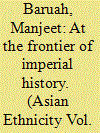

|
|
|
|
|
| Summary/Abstract |
Edward Gait’s A History of Assam was first published in 1906, later revised in 1926. The book has remained one of the most popular ‘textbooks’ in Assam, especially as the first modern historiography on the subject. This article looks at two broad issues in this regard. First, it looks at the contradictions that Gait was faced with in terms of his imperial ideology and interpreting the historical sources of an imperial frontier. Second, it tries to situate the relevance of the above point vis-à-vis some of the contemporary attempts at re-framing the region as an international borderland. In conclusion, the article looks at the reception of Gait and his appropriation into different discourses within Assam. A point explored is whether despite its contradictions, was Gait’s A History of Assam part of a wider, dynamic context of early twentieth century Assam, which made the book an important academic and political intervention of its times.
|
|
|
|
|
|
|
|
|
|
|
|
|
|
|
|
| 2 |
ID:
152996
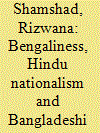

|
|
|
|
|
| Summary/Abstract |
Abstract
Hindu nationalists made migration from Bangladesh an election campaign in West Bengal during the 1990s. Although there were various allegations against Bangladeshi migration, it never became a mainstream political issue in the state, like in neighbouring Assam. West Bengal shares the longest border with Bangladesh, compared to any other Indian state, and hosts a large number of Bangladeshi migrants, according to the Census reports in India. West Bengal and Bangladesh share a common ethnicity, both are predominantly Bengali. Can this shared Bengaliness explain why Bangladeshi migration did not become a divisive political issue in the state? If this sameness is a bonding factor, what about the Ghoti-Bangal differences? Drawn from in-depth interviews with the representatives of West Bengal’s key civil society organisations and political parties, I argue that a particular historical and cultural process, unique to West Bengal and Bangladesh, has shaped the current attitude towards Bangladeshi migrants in the state.
|
|
|
|
|
|
|
|
|
|
|
|
|
|
|
|
| 3 |
ID:
153000
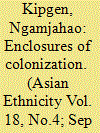

|
|
|
|
|
| Summary/Abstract |
This paper examines the Mapithel dam in Northeastern state of Manipur in India as a site of contestation between the state-led development agenda and the affected tribal people. Based on discursive field experiences, the paper reflects upon the competing values in relation to land use and ownership systems and raises a question – as to whether in the name of development, is the government eroding tribal people’s right over their land and resources? The Mapithel dam issue not only invites serious deliberations beyond dam construction and its social and ecological ramifications but also contemplates on the various dynamics in and through cultural identity, politics, and natural resources. The paper addresses some key aspects of the very political closure approach which emphasizes state’s hegemony through forceful intrusion into the life, livelihood, and ‘lebenswelt’ of tribal people and infringement of their traditional rights.
|
|
|
|
|
|
|
|
|
|
|
|
|
|
|
|
| 4 |
ID:
152999
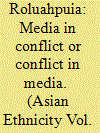

|
|
|
|
|
| Summary/Abstract |
The paper looks at how media engages with the issue of framing movements in the northeastern state of Manipur. The focus of the paper is on the demand for Inner Line Permit in Manipur that landed the state into conflict between the communities of the state. The passing of the three bills, as discussed in the paper, by the state government has snowballed into ethnic tensions and re-opened the hill–valley divide in this northeastern state. By using frame analysis, the paper intends to explicate the issue of media framing within the socio-political context of the state. The paper then engages with the process in which local media frames movements that are diametrically opposed to one another. The study further reveals that the local media in Manipur are greatly influenced by the local politics and remain integral to it.
|
|
|
|
|
|
|
|
|
|
|
|
|
|
|
|
| 5 |
ID:
153001


|
|
|
|
|
| Summary/Abstract |
South Korea has long been regarded as a country with a single ethnicity. Honhyeol, which literally means ‘mixed blood’ in Korean, exemplifies this orientation. In recent years, the number of ‘mixed race’ children in the country has been on the rise due to the increase in international marriages, particularly between Korean men and foreign women. Drawing on the personal narratives of 56 youths (aged between 9 and 17) obtained from three essay contests, this article examines how, why, and in which contexts the racial hierarchies of ‘mixed race’ children in Korea are constructed. Narratives of ‘mixed race’ children and their peers show that a ‘hierarchical racial order’ – characterized by a color-coding system that simultaneously operates along the lines of national origin – is channeled into ‘mixed race’ people’s everyday lives, thus shaping their identity constructions.
|
|
|
|
|
|
|
|
|
|
|
|
|
|
|
|
| 6 |
ID:
152998
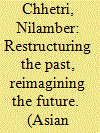

|
|
|
|
|
| Summary/Abstract |
This article is an empirical investigation into the recent demands made by ethnic groups for recognition as scheduled tribes (ST) in Darjeeling. These demands emerged in the early 1990s after the publication of the Mandal Commission Report and escalated in subsequent years. During the course of this study in 2014 there were 10 ethnic groups demanding recognition as ST. In recent years the developmental strategy adopted by the state government through the constitution of development boards for groups such as Lepcha, Tamang, Sherpa, and Bhutia has caused further escalation of these demands. Discussing these multifarious issues in Darjeeling, this article traces the historical legacy of these demands and discusses in detail formation of ethnic associations and their claims in recent time. Examining the interactions between ethnic associations and government agencies, this article will provide an empirical account of ethnic politics in Darjeeling and the response of the state in containing such demands made by ethnic minorities.
|
|
|
|
|
|
|
|
|
|
|
|
|
|
|
|
| 7 |
ID:
153003


|
|
|
|
|
| Summary/Abstract |
Studies on ethnic minorities for the Republican period (1912–1949) highlight the political agency these groups displayed in their negotiations with the modern Chinese state. Most of this work has focused on those non-Han groups officially recognized as part of the Five-Race Republic (wuzu gonghe). Little is known, however, about those excluded from the early Republic’s flag such as the Yi inhabiting southwest China. This article discusses the role played by a group of Yi leaders who engaged with Sun Yat-sen’s ideology of nationalism, racial equality, and anti-imperialism in their attempts to obtain both recognition and aid from the Chinese nation–state. Rather than rejecting the commonly used term to identify China’s non-Han population of ‘weak and small races’ present in Sun Yat-sen’s ideology, Yi elites appropriated this term to their advantage seeking aid from the Guomindang but at the same time placing boundaries to what they perceived to be a Han-centered state.
|
|
|
|
|
|
|
|
|
|
|
|
|
|
|
|
| 8 |
ID:
153002


|
|
|
|
|
| Summary/Abstract |
On 22 May 2014, the Thai military conducted a coup d’état and discarded the previous constitution. In April 2015, a new draft constitution was prepared. Although eventually rejected by the military, it represented an exciting moment for activists, as it recognized the existence of ‘indigenous peoples’ (referred to as chon pheun muang in the draft). This prompted us to conduct interviews in 2015–2016 with people belonging to four different ethnic groups and living mainly in Chiang Mai province, northern Thailand: the Lua, Khon Muang, Hmong, and Lisu, in order to determine their understandings of who should be considered ‘indigenous peoples’, and what rights should they have. The findings indicate that there is considerable variation amongst people regarding the meaning of the term ‘indigenous peoples’; who should be considered indigenous; and what rights those defined as being indigenous should be entitled to.
|
|
|
|
|
|
|
|
|
|
|
|
|
|
|
|
|
|
|
|
|